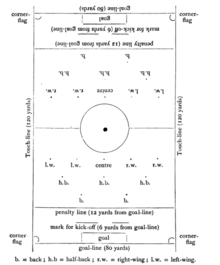
Back ملعب كرة قدم Arabic تيران د كورة ARY Futbol meydançası Azerbaijani Футбольнае поле Byelorussian Футбольнае поле BE-X-OLD Футболно игрище Bulgarian ফুটবল মাঠ Bengali/Bangla Nogometno igralište BS Camp de futbol Catalan Футбол уйĕ CV


A football pitch (also known as a soccer field in the United States)[1] is the playing surface for the game of association football. Its dimensions and markings are defined by Law 1 of the Laws of the Game, "The Field of Play".[2] The pitch is typically made of natural turf or artificial turf, although amateur and recreational teams often play on dirt fields. Artificial surfaces are allowed only to be green in colour.[2]
All line markings on the pitch form part of the area which they define. For example, a ball on or above the touchline is still on the field of play, and a foul committed over the line bounding the penalty area results in a penalty. Therefore, a ball has to completely cross the touchline to be out of play, and a ball has to fully cross the goal line (between the goal posts) in order for a goal to be scored; if any part of the ball is still on or above the line, a goal is not scored and the ball is still in play.[3]
The field descriptions that apply to adult matches are described below. Because of the role of the British football associations in the history of the game, the dimensions of the field of play were originally formulated and expressed in imperial units. Since 1999, the Laws of the Game have preferred metric units, with imperial equivalents given only in brackets. Because the actual values have, in general, not changed since the early twentieth century, they tend to be round numbers in imperial units (for example the width of the goal, unchanged since 1863, is 8 yards (7.32 metres)). Use of the imperial values remains common, especially in the United Kingdom.[citation needed]
- ^ For example, George Cumming, Manager Project Future Referees (9 December 2009). "Evolution of football field markings". Asian Football Confederation. Archived from the original on 23 October 2013.
- ^ a b "Law 1 - The Field of Play | IFAB". www.theifab.com. Retrieved 3 February 2023.
- ^ "Law 9 - The Ball in and out of Play | IFAB". www.theifab.com. Retrieved 12 February 2024.